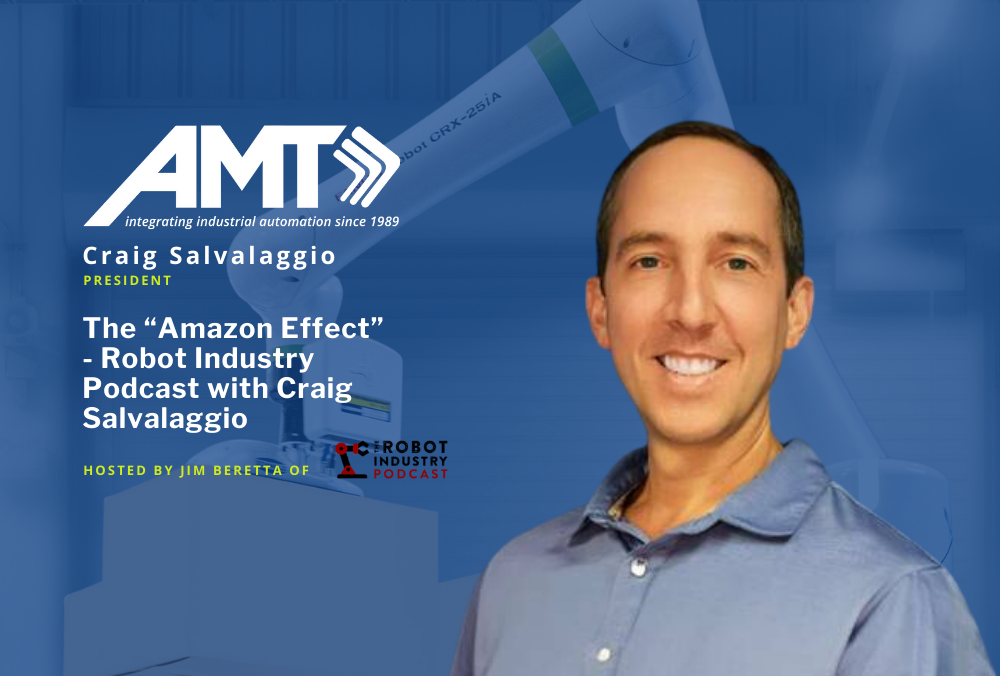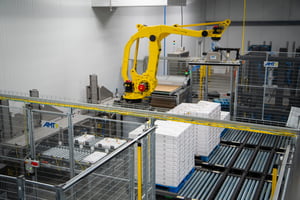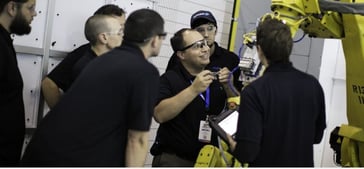“Amazon Effect” Robot Industry Podcast with Craig Salvalaggio
AMT’s Chief Operating Officer Craig Salvalaggio was interviewed by Jim Beretta of The Robot Industry Podcast, discussing the pandemic and the “Amazon effect” it has imposed on the industrial automation industry.
“We’re in unprecedented times, where organizations, specifically in the automation industry, are being challenged to accelerate demands to meet manufacturing needs,” said Craig. “Being in the robotics and industrial automation industry, we feel that this is a necessary part of the future of how manufacturing will be handled I the U.S. We can relate it to similar stories, such as Amazon, with their large growth trajectory and ability to scale quickly, and apply that to system integration companies and automation in general.”
Craig delves into the segments of the automation industry that are experiencing the greatest rate of change, and illuminates considerations when trying to meet the challenges of these unique market conditions. Jump to sections:
- Accelerating Industry Changes in 2020
- The “Amazon Effect”
- Overseas Suppliers During a Pandemic
- Collaborative Robotics and Time to Integration
- Reshoring Challenges and Rethinking Partnerships
- Choosing the Right System Integrator Partner
- Talent in the Automation Industry
- Accelerating Your Business
Accelerating Industry Changes in 2020
Taking a look at how the pandemic has played out in 2020 with businesses, Craig says, “It’s really interesting what markets were impacted, some negatively, some positively. When you look at what turned on quickly and how that impacted the supply chain, it was very interesting.” He notes that early in spring 2020, companies selling various types of recreation equipment such as boats, recreational vehicles or home leisure items such as hot tubs had a sudden and tremendous growth in sales, but there were problems. The supply chain wasn’t set up for the explosive growth, and when the stay-at-home orders were lifted, these industries were sold out of inventory in days.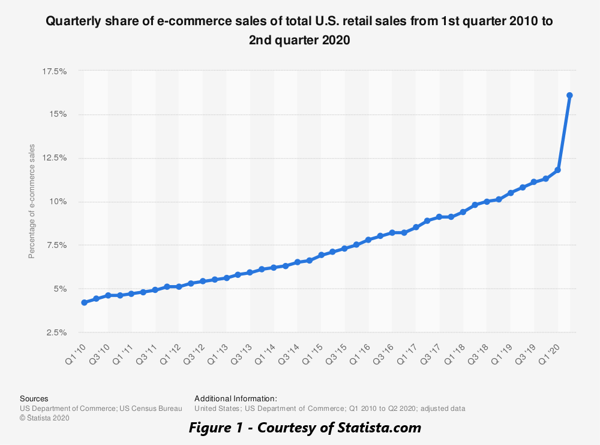
“Sections of the industry really weren’t ready for this shift in the market, from an inventory standpoint and supply chain models, it really couldn’t react fast enough,” said Craig. “Think about it: in 2020, it’s a six-month lead time to purchase a professional mountain bike and the explosive growth was not something that those companies were ready for.”
Figure 1 illustrates how consumer spending habits have dramatically shifted as a result of the pandemic, especially the supply chain for e-commerce home delivery and buy online/pick up in-store. “This market has exploded. Now you’re seeing a much different scenario: a micro fulfillment center at the store. For example, if you look at the grocery industry, there are so many pickers in the stores fulfilling those buy online/pick up in-store needs. When you start to get over 6% of the store filled with pickers versus actual direct consumers, you start to turn those stores into essentially a mini factory,” said Craig.
The market in general automation is predicted to accelerate and enable these new services and speed of fulfillment and delivery. “The conditions are now set: two-day shipping and accelerated curbside pickup are now services that are expected. If you take a look at automation for order turn-time and accuracy, the systems built in factories early on and built in fulfillment centers are not typically found at the store-level of the distribution chain. This is transpiring to the store centers now.”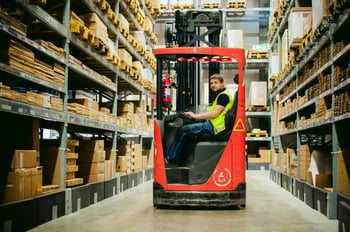
Taking a closer look at traditional fulfillment and distribution center automation, Craig remarks, “Automation can only help accelerate the decisions that were previously made in a traditional labor-intensive world, especially where goods-to-people are required. When you look at automation, the warehouse fulfillment e-commerce centers are requesting faster time-to-market, and we saw this specifically with the pandemic supply chain.”
Other industries have had new, urgent needs for automation in 2020 as well. “When you look at consumer goods, we saw early on how things changed where there was a desperate need for additional hospital beds and the welding market in automation was required. We saw early requests for gown and mask production, and how you can take a piece of traditional automation and shift it over to produce those. We saw that drastically in the medical and test equipment industry as well. Also, manufacturers that have a heavy manual labor process with operators in close proximity, they are now investigating their five- and ten-year automation strategy.”
In addition to rearranging workspaces to accommodate social distancing, companies are reevaluating their virtual and office guidelines. Many believe these changes are here to stay. “Going back to the normal is not likely an option,” said Craig.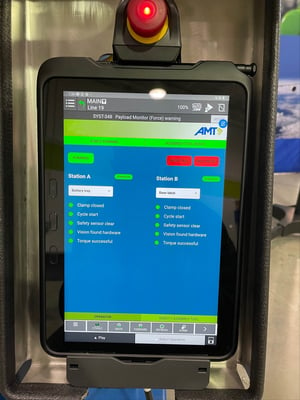
As consumer expectations at the retail level have changed, this trickles down to the factory level. “Customers are requesting ease-of-use upgrades such as an easier to use HMI. You don’t need to be an engineer to operate the manufacturing system, and as a system integrator, we take a lot of those design considerations on modularity and ease of use into new markets that aren’t heavy users of either robotics or traditional automation.”
Craig continues, “The use of visual indicators, the use of data telling the story – all that has to be included, and it’s not your traditional cycle-hold, cycle-start and fault messages. You really have to look at how the operator can interface with the machine and understand exactly how the equipment is behaving.”
The “Amazon Effect”
“Increased speed to market is really the ‘Amazon effect,’ “ said Craig. “We talk about Amazon because it’s a great company that portrays how time-to-market demands are changing. And really, when you look at an organization that can scale that quickly, that is that complex, it’s an amazing story. I also reference this because I like to highlight something called the ‘flywheel effect.’ Many people can relate to the legendary author Jim Collins and his book Good to Great, in which he highlights companies that made the leap to greatness versus those that did not. The research shows that there’s only a marginal percentage of companies that can become great by circumstances alone, and why it’s largely a matter of conscious choice about people and strategy along with hard work and discipline. There are several concepts highlighted throughout the research, but the most reliable and relatable is the flywheel.”
“Picture the flywheel as a huge, heavy axle weighing many tons, and that flywheel is your 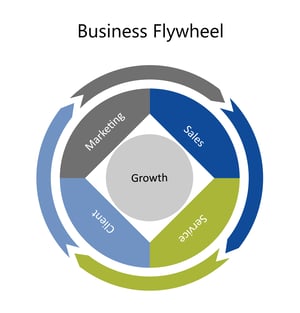 organization. When a new business forms, or an activity comes to a stop which it did for many companies during the pandemic, how do you get that flywheel rotating again? When you are first pushing on that flywheel to get that economic engine moving, it takes a massive effort from a massive, cohesive team that’s all working on the same project, the same thematic goal. Then you get that second rotation, third rotation, and now momentum turns in your favor. That’s what we are calling the ‘Amazon effect’ here; once the business understands where it’s going and everybody’s on the same page… You can really accelerate by applying that to automation.”
organization. When a new business forms, or an activity comes to a stop which it did for many companies during the pandemic, how do you get that flywheel rotating again? When you are first pushing on that flywheel to get that economic engine moving, it takes a massive effort from a massive, cohesive team that’s all working on the same project, the same thematic goal. Then you get that second rotation, third rotation, and now momentum turns in your favor. That’s what we are calling the ‘Amazon effect’ here; once the business understands where it’s going and everybody’s on the same page… You can really accelerate by applying that to automation.”
Craig observes the same effect is happening in automation. “Especially in industries such as warehousing and logistics, medical testing, and heavy manufacturing – companies that are hit by labor challenges – they are trying to accelerate these automation initiatives to meet the market demand. Integrators are all being faced with massive pre-ordering of components because of increased lead times. In some cases, we’ve seen examples where you are releasing the arm or the panel design for builds and the engineering is not fully complete. What would normally be in-stock items, whether it’s guarding or standard components for an electrical panel, they are seeing extended delays in shipment.”
Overseas Suppliers During a Pandemic
During the pandemic, some industry sectors were completely shut down while others accelerated. “The ones that accelerated hard out of this were impacted,” Craig said. “What we want to look at, from an installation standpoint, is travel restrictions. How does this impact ROI on your equipment?”
The AMT team witnessed plenty of companies that were negatively impacted by the spring 2020 travel restrictions. “There was one week in early June where we were getting calls almost daily from domestic companies whose strategy was to leverage overseas integration organizations and product companies,” said Craig. “All the overseas companies that were here for an installation at that time had to leave the country. They are not being allowed to return, whether it’s because of travel restrictions or government agencies placing travel bans in different areas. The U.S. manufacturer is then left with a machine that is half installed, half programmed, and not producing the ROI on the parts in the manufacturing operation it was intended to serve.”
Many of these companies found AMT through vendor or other types of referrals and reached out. “It was one week; it was almost comical to see how many calls were coming in for that level of support. Our unique business model allowed us to react and be nimble and provide just the amount of offering that was required to be able to step in and take some of those over and help out. We were proud that we can do that. Overall, for systems integrators, there’s a great opportunity to revisit processes within your organization, really understand how we can learn from this. If we can accelerate growing markets without skipping steps and not think of everything in the traditional 28-32-week lead time. Think of it from a different perspective and without skipping steps in the process and look at it from a different design perspective.”
Collaborative Robots and Time to Integration
Robotics, especially collaborative robotics, has had a tremendous amount of play in the media recently. “There are a lot more people now that are being exposed to different types of robotic automation, and the technology is new to a different aspect of the market,” said Craig. “When you talk about collaborative robotics, what we are really talking about is collaborative system design and application.
Collaborative robotics has become a hot topic in recent years due to what Craig refers to as the “trade show effect,” where leadership investigates new technologies they have seen debuted at trade shows and subsequently instigates an organizational mandate to install the technology in their production, whether it is ready for prime time or not.
Craig notes that currently many organizations are looking to automate where they have labor-related challenges and collaborative robotics is top of mind. “Typically, these start with large volume requests. We see this quite often where the request is a very accelerated delivery – a very accelerated go-to-market strategy.” AMT advises potential adopters of collaborative robotics to take the time to look for proper applications that produce proper ROI. “Adding collaborative robotics can have a really negative or positive long-term effect on your manufacturing organization, depending on how you introduce the topic from a culture-standpoint within your company.”
“At AMT, we are seeing this happen,” said Craig. “The market is now loaded with options promising safe, cheaper, and flexible smaller-footprint systems. From a collaborative standpoint, you need to look at it from a different perspective. Before you make the investment, you have got to ask yourself a couple of questions really early on.” AMT educates potential users by first illustrating the applications better suited for a traditional industrial robot. AMT engineers study the customer’s situation to determine if power- and force-limiting capabilities are truly required in the particular situation. If these capabilities are indeed required, additional constraints are examined such as the payload, robot reach, speed, required accuracy, and whether it is high-volume, high-speed production.
Craig discusses the constraints of designing effective collaborative robotics systems, “If you want to head down a power- and force-limiting route, you look for different things, such as throughput similar to a human worker. You look at the ease of use and the ability to program and set up a robot, potentially with in-house engineers or maybe by leveraging some partners. You also look at the ability to redeploy the system to a different process or task. In some cases, customers purchase a ‘do it yourself’ model, but in most cases, you still need a traditional integrator to evaluate the application and ensure that it’s going to be successful.”
Safety requirements for collaborative robotic systems also need to be considered. “It’s not just the arm itself, it’s the entire application.” said Craig. “When you look at safeguarding requirements, these need to be determined by a risk assessment. If you are new to automation, this is where you may want some guidance. There are plenty of how-to guides and templates through RIA, the Robotic Industries Association, that can guide you down the right path. But at the end of the day, you need a comprehensive risk assessment to assess not only the robot itself, but the environment in which it’s placed. You have to be addressing things like the hazards, the gripper and actuation, and the entire piece of machinery within the cell.”
Beyond ensuring that the application is suited for a collaborative system and safety 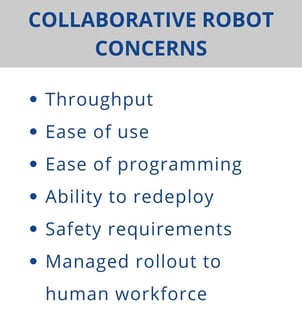 requirements can be met, the third piece to be considered is how to introduce this new technology to the human workforce. “From a surface level, customers think the collaborative system appears simpler and easier to use and maybe could be done themselves versus hiring a system integrator. We tell people to look deeper in their organization, from a cultural standpoint and from a bandwidth standpoint, and put your internal readiness checklist together.”
requirements can be met, the third piece to be considered is how to introduce this new technology to the human workforce. “From a surface level, customers think the collaborative system appears simpler and easier to use and maybe could be done themselves versus hiring a system integrator. We tell people to look deeper in their organization, from a cultural standpoint and from a bandwidth standpoint, and put your internal readiness checklist together.”
What measures are currently in place within your manufacturing organization?
- From a people standpoint
- From a process variability standpoint
- The data – Do you have current- and future-state information on your automation? Or intentions for automation? How is it currently measured and how will you measure it in the future because you are going to build this into your technology plan.
- Communication – How are you going to communicate the enablement of these new technologies within your factory to your workforce? How will it be rolled out? Will you introduce the technology as technology that enables more productivity? How you do that is very impactful to the culture of your organization.
- Operator training – Training your staff to accept and own the equipment is probably the simplest but most overlooked thing that companies need to do. When you look at your entire staff, from operators to maintenance, to safety, to engineering… If you educate people on the impact of the technology, the ability of what it can do to help the company be more successful, and more productive, you are going to get the buy-in early on and people won’t be as reluctant to accept what it’s going to do for the organization.
- Ease of use – It’s got to be easy to use. It’s got to work. It’s got to meet the throughput rates and it can’t be too complicated. The GUI and the interface have to be more relatable to what you are seeing in consumer goods. It can’t be this complex piece of machinery that needs to have coding done every time.
- Safety – From an operator standpoint, ensure that they understand the risks associated with doing their job, and then ensure that this breaks all the way down to results.
The importance of getting buy-in from the customer’s workforce is paramount. “It’s one thing to create a system that will meet production goals, but it’s also critical to get the workforce acceptance of the system and turn it over to the plant to ensure that the mix of human and robotic labor interaction can be successful,” said Craig.
Reshoring Challenges and Rethinking Partnerships
Recently, AMT has seen companies large to small really start to evaluate reshoring initiatives. “One of the hardest hit areas during the pandemic was how the supply chain was impacted. It rippled down from executive orders and travel restrictions to supplier issues and lack of components. Delays created all kinds of broken links in the supply chain. Some companies used this as an opportunity to rethink partner relationships and set a longer-term strategy to where everything is made in the U.S.A.”
This strategy is not possible for all companies who might prefer to move their supply chain back to the U.S. “They may have infrastructure in place in different countries and really couldn’t cost-justify relocating those plants,” Craig said. “A lot of companies really did a pretty deep evaluation. I can think of at least a dozen examples of U.S.-based manufacturing companies that had partnered with the overseas integrators or overseas technology partners and had many startup issues that are still unresolved, leaving the end user with equipment that can’t produce the components or the products that it was intended to make. Some of the issues are equipment-based, others are travel-restriction related, but the opportunity here is
for the end user to revisit partners, and not only the partners that they currently have, but how they evaluate potential future partners.”
To compare the reshoring perspective versus manufacturing globally, Craig suggests evaluating how nimble is the blend of labor and materials in each region. “Specifically, it’s more critical than ever to look at industries such as fast-moving consumer goods and pharmaceuticals and understand where these products come from, from a raw material standpoint. Really what we suggest is to revisit what’s a vendor and what’s a partner. We have the ability right now to be very intentional with who we want to do business with.”
Choosing the Right System Integrator Partner
It’s of critical importance to choose a system integrator that can work as a partner to you and help you achieve both your short- and long-term goals. Craig said, “The RIA has a program called the Certified Robot Integrator Program that helps break down the process for choosing a system integrator partner, which has been discussed in a RIA workshop I hosted in summer 2020. We break down the process so you are looking at more value than price alone.”
At a high level, there are many criteria that companies should consider to choose the right system integrator for their project. “Regardless of certification; this is from a different perspective,” said Craig. “At AMT, we always talk about right-sizing your business with the end user. Some companies are taking on too large of projects; some companies are taking on too small of projects and not paying enough attention to them. We recommend looking at the size of the project, the type of application, and your internal experience, and then we evaluate the business processes that the company has. Look at your program management, how you do risk assessments, how you do buy-off… Do you have a scorecard that you can share with the end user, as far as the organizational processes they have?”
Craig continues, “Update yourself with the new safety standards, implement risk assessments and ensure that projects are kicked off with fully-accepted customer expectations at the beginning and all the way through. It is critical to not skip steps. The ‘Amazon effect’ really impacts automation companies and this is a good reminder that as you are accelerating, skipping steps will always lead to issues down the road. Follow those organizational processes that you have in place to ensure you are always doing those different gate points for factory acceptance and site acceptance and meeting the agreed-upon timeline and scope of the project.”
“AMT has a very detailed score card that RIA uses, but at the end of the day, we want to start going through a different process than price alone for partnerships and reevaluate what that would look like to have an overseas partner along with a U.S.-based partner if we were to ever run into these kind of challenges in the future.”
Talent in the Automation Industry
From an employee talent standpoint, there is a very specific skillset that is needed to be successful in the automation industry. The traditional skills required by a system integrator used to be machine designer, checker, simulation, engineer, controls designer for hardware, PLC programmer, and robot programmer. “Our next generation of automation professionals have grown up with professional, studio-level graphics NVIDIA processing power, and technology that doesn’t need a work instruction,” said Craig. “Historically, we have spent months developing manuals for how this automation would work and the next generation of professionals doesn’t want a manual – instead, the system needs to be that intuitive. The industry is now changing to a very software-driven world where a minimum of 2-3 of those categories are now the new normal, where a single engineer is expected to be able to lay out a job, process it, and even write the software and do the design. We, along with several other integrators, now say that we hire a controls engineer and teach them how to process a job and program robotics. They need to be savvy on multiple platforms and need to understand safety processors – it’s no longer an option NOT to include them on most systems nowadays. Every PLC programmer should also understand where the data is going and really understand the server-side of things, from PC-protocols to doing something from an analytics perspective with the data.”
Technology is now being introduced to students earlier than ever. Craig notes, “ There’s also a new working environment with industry certifications, levels of capability… this stuff wasn’t available in the past. It’s now available through the colleges, it’s available through the high schools, and it’s available through programs such as FIRST robotics. We are introducing technology and manufacturing at a much earlier stage in people’s lives. For AMT, what we’ve always looked for is not necessarily the hard skills, but it’s more about aptitude and the ability to learn. If you have mechanical aptitude and you understand how a machine works, we can teach you PLC programming. When we are interviewing and looking for people, we are looking for that learning ability, that learning agility as well, for them to be able to understand multiple things, where they are aspiring to be, how engaged they are, and have a passion for what they are doing, and then that emotional IQ because of the independent nature of our work and the professionalism that’s required. Beyond the hard skills of understanding how to write software or program a PLC or robot, we are really looking for a different set of characteristics. People that want to learn – we think we can teach them just about anything.”
There’s also a new working environment with industry certifications, levels of capability… this stuff wasn’t available in the past. It’s now available through the colleges, it’s available through the high schools, and it’s available through programs such as FIRST robotics. We are introducing technology and manufacturing at a much earlier stage in people’s lives. For AMT, what we’ve always looked for is not necessarily the hard skills, but it’s more about aptitude and the ability to learn. If you have mechanical aptitude and you understand how a machine works, we can teach you PLC programming. When we are interviewing and looking for people, we are looking for that learning ability, that learning agility as well, for them to be able to understand multiple things, where they are aspiring to be, how engaged they are, and have a passion for what they are doing, and then that emotional IQ because of the independent nature of our work and the professionalism that’s required. Beyond the hard skills of understanding how to write software or program a PLC or robot, we are really looking for a different set of characteristics. People that want to learn – we think we can teach them just about anything.”
Accelerating Your Business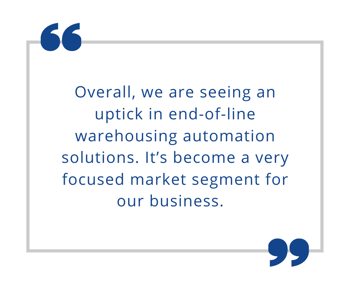
The changing consumer expectations on speed of delivery and in-store pickup are here to stay. “When you look at applications and which industries are ramping up and look at the changing consumer buying and spending habits, it comes back to the concept of the omni-channel distribution model which is buy online, pick up in store in two hours.”
Craig believes that automation is going to be a bigger and bigger part of this market. “In some cases, it’s not the traditional automation user that you would find in the traditional factory. Sometimes the easiest place to impact throughput and ROI is on the labor-intensive end-of-line operations. Palletizing in general is a great application for robotics. It’s got its unique challenges when you look at different tooling design, the product, and the throughputs required. Overall, we are seeing an uptick in end-of-line warehousing automation solutions outside of the standard warehousing distribution centers. It’s become a very focused market segment for our business. More companies are looking to automate the back half of their factories and seeking out use cases that convert those manual tasks that drive their workforce turnover.”
Circling back to the pandemic and the “Amazon effect,” Craig says, “With many 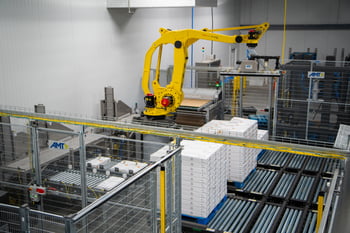 companies struggling to put labor back to work through this pandemic, we have seen how fragile systems can be without automation. Currently, there are a lot of non-traditional applications investigating ROI for automation and we are seeing the opportunity to educate our buyers on a different aspect of the business. We are continually working with new organizations, but you look at the technology turnover and the people turnover, and the technology is moving fast. Labor continues to be a challenge in many factories.”
companies struggling to put labor back to work through this pandemic, we have seen how fragile systems can be without automation. Currently, there are a lot of non-traditional applications investigating ROI for automation and we are seeing the opportunity to educate our buyers on a different aspect of the business. We are continually working with new organizations, but you look at the technology turnover and the people turnover, and the technology is moving fast. Labor continues to be a challenge in many factories.”
“We are telling people to pick the right technology and it will open up the door for really accelerating your business and understanding how to be cost competitive, successful, and open up new career paths within your organization.”
LISTEN TO THE FULL PODCAST EPISODE
For more information about AMT or our services, please contact us at the link below.

